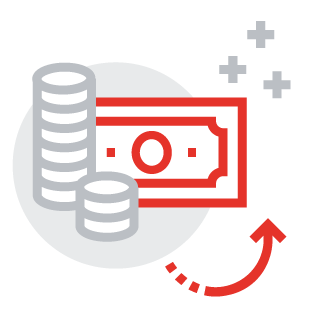Financial Infrastructure Report 2023
With its annual Payment Systems Report, Banco de la República offers a complete overview of the infrastructure of Colombia’s financial market.
Each edition of the report has four objectives:
1) to publicize a consolidated account of how the figures for payment infrastructures have evolved with respect to both financial assets and goods and services;
2) to summarize the issues that are being debated internationally and are of interest to the industry that provides payment clearing and settlement services;
3) to offer the public an explanation of the ideas and concepts behind retail-value payment processes and the trends in retail payments within the circuit of individuals and companies; and
4) to familiarize the public, the industry, and all other financial authorities with the methodological progress that has been achieved through applied research to analyze the stability of payment systems.
Consulte el Reporte completo de 2023
Main Points: 2023
Banco de la República monitored fnancial market infrastructures (FMIs) in Colombia continuously throughout the year.
The central bank monitored their performance continuously, using risk assessment methods and putting the fndings of applied research into practice to detect possible challenges to fnancial stability that could arise from problems or disruptions in FMIs.

The domestic fnancial infrastructure in 2022 was safe and effcient.
Colombian FMIs were extremely resilient in the face of economic and fnancial challenges, both domestic and international. Thanks to effcient management, the payment system and fnancial markets were able to operate normally, providing stability and confdence to their participants. As proof of this, the fnancial infrastructure maintained its services on a continuous basis, showing general evidence of its safe and adequate operation.

During the year, the FMIs refected the movement in domestic fnancial markets.
Primarily, the fxed-income market showed positive developments in traded volumes, despite experiencing devaluations (in a context of increased infationary pressures, tighter fnancial conditions and added global and local uncertainty). The foreign exchange market, which experienced important levels of volatility during the year, registered signifcant momentum in TRM-indexed products cleared and settled through the CRCC.

There was more activity in the largevalue payments system.
Banco de la República’s large-value payments system (CUD) saw an increase in activity compared to the previous year, thanks to more momentum the market for public debt (purchases and sales and sell/buy-back agreements), repos to expand money supply, and retail-value payments (electronic funds transfers, checks and cards). This dynamic was offset partially by lower balances for government interest-bearing deposits.

Added force was observed in fnancial market infrastructures.
As a result of CUD activity, the amounts cleared and settled through the Central Securities Depository (DCV) were larger because of an increase in money market operations involving public debt. There was an increase in operations managed by the Central Counterparty Clearing House (CRCC), due to the addition of temporary transfers of sovereign-debt securities (TTS) in the fxed income segment and positive developments in underlying TRM products (futures, NDF forwards and options).

The initial balance in the CUD and the simulated netting cycles in the DCV made a positive contribution toward mitigating intraday liquidity risk in the large-value payment system.
The evolution in several intraday liquidity indicators proposed by the Bank for International Settlements (BIS) showed the CUD maintained enough liquidity to make payments. As for the DCV, its simulated netting cycles have proven to be an effective option for generating liquidity savings in the system. A change in the cycles would imply an exhaustive evaluation of all the available simulated netting options, invariably seeking an adequate balance between effciency and risk, with the objective of achieving an optimal and safe netting process.

A review of the margin management practices used by central counterparties (CCP) in stressed market incidents showed the CRCC was resilient to market turbulence during the frst half of 2020. The measures used to mitigate procyclicality avoided high margin requirements for members during times of increased volatility.
The higher initial and variation margin requirements caused by extreme market volatility during 2020 were mitigated by mechanisms the CRCC put in place (such as large position management and a buffer in the margin model) to reduce the impact on its clearing members. This counter-cyclical response made it possible to adequately manage the liquidity of market participants during a period of high volatility and risk aversion.

Several recommendations and developments in international regulations recognize the importance of having special regimes for CCP.
The functions and business models of fnancial institutions and CCPs are different, as are the risks inherent in one and the other. Consequently, the resolution strategies, powers and capabilities of fnancial authorities should be specifc for the CCPs. In this respect, further analysis to create a special resolution regime for the CCPs in Colombia would be important, considering that the CRCC’s contribution to mitigating counterparty and liquidity risks is essential for developing markets and fnancial stability in the country.

Adequate cyber resilience in fnancial infrastructures is a relevant factor for maintaining fnancial stability in Colombia.
Internationally, cyber risk is regarded as one of the most relevant risks. Therefore, its effective management has been the focus of recommendations from multilateral organizations. In Colombia, the SFC has established guidelines, protocols, and standards in light of these recommendations. Together with the policies and practices implemented by Banco de la República (Banrep), they have facilitated joint efforts on the part of authorities, fnancial infrastructures, and their participants to address cyber risks in a coordinated manner and to help strengthen cyber resilience in the Colombian fnancial sector.

Electronic retail payments increased in 2022.
The added use of payment channels, such as the Internet and mobile telephones, contributed to the growth in electronic payments. The increase in electronic transfers (both inter- and intra-bank), and their use in mobile wallets, recognized as closed payment schemes, is worth noting.

Cash is still the payment instrument most used by Colombians for routine payments.
The latest measurement of the survey on perception of the use of payment instruments conducted by Banrep (2022) showed the instrument most used by Colombians for routine payments continues to be cash. Additionally, the value of banknotes in circulation, as a proportion of GDP over the last ten years (a proxy indicator of cash payments), showed an upward trend, consistent with the behavior of the same indicator in different countries.

Technological advances in payments have led to the possibility of including additional services, such as programmable money and smart contracts.
These innovations eventually could be considered in the design of a central bank digital currency for use by the general population and businesses (a retail CBDC). A deeper understanding of how they work is helpful in recognizing their potential scope, as well as their benefts and risks.

EThere is an international trend in the use of standardized messaging to facilitate interoperability in payments.
ISO 20022 is a standard for messaging in the fnancial industry. It offers a common language with more complete data that allows for effciency in processing different types of payment, harmonization between fnancial infrastructures, fraud detection and improved user experience. Internationally, the case of England is particularly relevant for outlining a long-term plan to incorporate standardized messaging. Locally, the new DCV has adopted standard messaging and plans to include it in instant payment systems.

Cifras clave, 2023
(en promedio diario de 2022 y cambio anual, porcentaje)
Por infraestructura

Transacciones liquidadas en CUD
| Valor | Cambio | Número | Cambio | |
|---|---|---|---|---|
| Nominal | Real | |||
| COP 61,3 b | 15 % | 2 % | 6.765 | 9 % |

Pagos en los mercados financieros
| Valor | Cambio | Número | Cambio | ||
|---|---|---|---|---|---|
| Nominal | Real | ||||
| DCV | COP 43,0 b | 25 % | 10 % | 2.425 | 13 % |
| CRCC | COP 31,5 b | 18 % | 4 % | 8.503 | 18 % |
| Deceval | COP 3,0 b | 15 % | 1 % | 6.540 | 45 % |
| COP 77,5 b | 21 % | 7 % | 17.468 | 26 % | |

Pagos al por menor
| Valor | Cambio | Número | Cambio | ||
|---|---|---|---|---|---|
| Nominal | Real | ||||
| ACH Colombia | COP 6,8 b | 21 % | 7 % | 1,3 m | 10 % |
| ACH Cenit | COP 1,3 b | 13 % | 0 % | 91.315 | 37 % |
| Redes TyC | COP 0,7 b | 55 % | 37 % | 5,1 m | 54 % |
| Cedec | COP 0,6 b | -2 % | -13 % | 19.256 | -16 % |
| COP 9,4 b | 20 % | 6 % | 6,6 m | 42 % | |
Por instrumento

Transferencias
| Valor | Cambio | Número | Cambio | ||
|---|---|---|---|---|---|
| Nominal | Real | ||||
| Intra Inter | COP 12,9 b COP 8,1 b | -5 % 20 % | -16 % 6 % | 6,2 m 1,4 m | 88 % 11 % |
| COP 20,9 b | 3 % | -9 % | 7,7 m | 67 % | |

Operaciones con tarjetas
| Valor | Cambio | Número | Cambio | ||
|---|---|---|---|---|---|
| Nominal | Real | ||||
| Débito Crédito | COP 997 mm COP 261 mm | 18 % 32 % | 4 % 17 % | 3,8 m 1,1 m | 21 % 28 % |
| COP 1,3 b | 21 % | 7 % | 4,9 m | 22 % | |

Operaciones con cheques
| Valor | Cambio | Número | Cambio | ||
|---|---|---|---|---|---|
| Nominal | Real | ||||
| Intra Inter | COP 221 mm COP 610 mm | -4 % -2 % | -15 % -13 % | 11.272 19.256 | -14 % -16 % |
| COP 851 mm | -2 % | -4 % | 30.528 | -15 % | |





















































